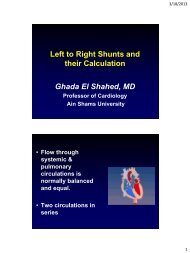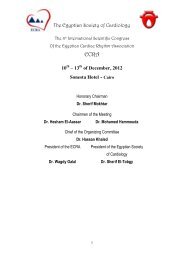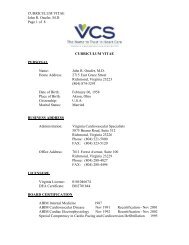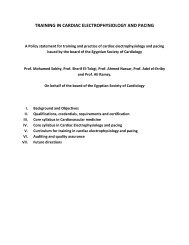the egyptian society of cardiology board of ... - Cardioegypt.com
the egyptian society of cardiology board of ... - Cardioegypt.com
the egyptian society of cardiology board of ... - Cardioegypt.com
You also want an ePaper? Increase the reach of your titles
YUMPU automatically turns print PDFs into web optimized ePapers that Google loves.
Ayman Sadek, et al<br />
had documented obstruction <strong>of</strong> distal arteries <strong>of</strong><br />
<strong>the</strong> leg (Peripheral angiography or lower limb<br />
arterial duplex).<br />
The following patients were be excluded from <strong>the</strong><br />
whole study:<br />
Previous neck or femoral irradiation, Previous<br />
neck or femoral surgery, or any neck or lower limb<br />
deformity interfering with carotid or femoral ultrasonography<br />
respectively.<br />
Methods:<br />
Every patient was subjected to <strong>the</strong> following:<br />
Proper history taking and examination:<br />
Full history for <strong>the</strong> presence <strong>of</strong> cardiovascular<br />
risk factors:<br />
Smoking, Hypertension, Diabetes mellitus,<br />
Dyslipidemia, Family history <strong>of</strong> ischemic heart<br />
disease, Symptoms suggestive <strong>of</strong> coronary artery<br />
diseases Peripheral vascular disease Cerebrovascular<br />
strokes or transient ischemic attacks:<br />
Complete general and local clinical examination<br />
with stress on <strong>the</strong> following points:<br />
Weight: Measured in kilograms.<br />
Height: Measured in meters.<br />
Body mass index = Weight in kilograms/(height<br />
in meters) 2<br />
Table 1: Criteria for clinical diagnosis <strong>of</strong> metabolic syndrome.<br />
Measure<br />
(any 3 <strong>of</strong> 5 constitute<br />
diagnosis <strong>of</strong> metabolic<br />
syndrome)<br />
Elevated waist circumference*<br />
Elevated triglycerides<br />
Reduced HDL-C<br />
Elevated blood pressure<br />
Elevated fasting glucose<br />
Categorical<br />
Cutpoints<br />
≥102 cm (≥40 inches) in<br />
men ≥88 cm (≥35 inches)<br />
in women<br />
≥150 mg/dL (1.7<br />
mmol/L)Or On drug<br />
treatment for elevated<br />
triglycerides<br />
≤40 mg/dL (1.03 mmol/L)<br />
in men≤50 mg/dL (1.3<br />
mmol/L) in women<br />
≥130 mm Hg systolic blood<br />
pressure or ≥85 mm Hg<br />
diastolic blood pressure<br />
or On antihypertensive<br />
drug treatment in a patient<br />
with a history <strong>of</strong><br />
hypertension<br />
≥100 mg/dL or On drug<br />
treatment for elevated<br />
glucose<br />
41<br />
Pulse: Radial, brachial with stress on pulse<br />
pressure and dorsalis pedis arteries were examined<br />
for rate, rhythm, volume, special character and<br />
equality <strong>of</strong> pulsations.<br />
Morning urine sample to measure microalbuminuria:<br />
Using HemoCue Urine albumin operator<br />
manuals instrument.<br />
1- We open <strong>the</strong> package and carefully remove <strong>the</strong><br />
cuvette <strong>the</strong>n we fill <strong>the</strong> cuvette by contact with<br />
<strong>the</strong> urine sample (a urine drop on a hydrophilic<br />
surface i.e a plastic film).<br />
2- Open <strong>the</strong> lid and push <strong>the</strong> filled cuvette into <strong>the</strong><br />
cuvette holder.<br />
3- Measuring should begin within 30 seconds after<br />
<strong>the</strong> cuvette has been filled with urine.<br />
4- Within 90 seconds <strong>the</strong> result will be displayed<br />
in mg/dl.<br />
12 lead surface ECG:<br />
Echocardiography:<br />
Echocardiography was done for measurement<br />
<strong>of</strong> (LVEDD), (LVEDD, (EF), (LVPWT) and<br />
(IVST).<br />
And assessment <strong>of</strong> RSWMA.<br />
Carotid and femoral arterial duplex:<br />
All patients underwent ultrasonography <strong>of</strong> <strong>the</strong><br />
right and left carotid and femoral arteries where<br />
<strong>the</strong> following measured:<br />
1- Carotid intima-media thickness (IMT):<br />
The characteristic B-scan pattern <strong>of</strong> <strong>the</strong> arterial<br />
walls shows two parallel echogenic lines separated<br />
by a relatively hypoechoic space "<strong>the</strong> double line<br />
pattern". This pattern is found in <strong>the</strong> posterior wall<br />
<strong>of</strong> <strong>the</strong> <strong>com</strong>mon carotid arteries; <strong>the</strong> inner line is<br />
generally more regular, smooth and thin than <strong>the</strong><br />
outer one and represents <strong>the</strong> lumen intima interface.<br />
The outer one is produced by <strong>the</strong> collagen containing<br />
upper layer <strong>of</strong> tunica adventitia, close to <strong>the</strong><br />
media-adventitia interface.<br />
The intima-media thickness (IMT) is measured<br />
from <strong>the</strong> leading edge <strong>of</strong> <strong>the</strong> inner line to <strong>the</strong><br />
leading edge <strong>of</strong> <strong>the</strong> outer one [14].<br />
An ultrasonographically determined increase<br />
in IMT may be regarded as an indicator <strong>of</strong> generalized<br />
a<strong>the</strong>rosclerosis [15].<br />
We measured <strong>the</strong> carotid IMT bilaterally by Bmode<br />
ultrasonography (7-8MHz linear array, gen-








